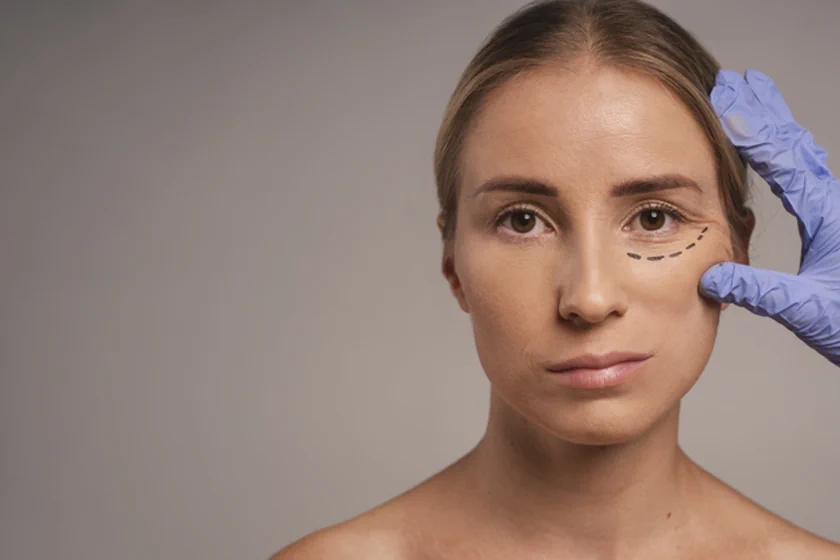|
Getting your Trinity Audio player ready...
|
Droopy eyelids, also known as ptosis, can significantly impact both the appearance and functionality of the eyes. Affecting individuals of all ages, this condition often leads to a tired or aged appearance and, in severe cases, can impair vision. Recent advancements in medical science offer various droopy eyelid treatment options, ranging from non-invasive techniques to surgical interventions.
Research indicates that ptosis affects approximately 11.5% of adults over the age of 50, with prevalence increasing with age. Moreover, according to a study published in the Journal of Plastic, Reconstructive & Aesthetic Surgery, patients undergoing droopy eyelid surgery reported a significant improvement in their quality of life and visual function.
This blog will delve into the essential droopy eyelid treatment methods, examining both surgical and non-surgical approaches. We will explore the latest research-backed techniques, discuss the benefits and risks, and provide insights into choosing the right treatment to enhance both beauty and vision.
Understanding Droopy Eyelids
Droopy eyelids, medically termed ptosis, refer to the condition where the upper eyelid droops over the eye. This condition can affect one (unilateral ptosis) or both (bilateral ptosis) eyelids and ranges from mild sagging to severe cases where the eyelid covers the pupil, impairing vision.
Causes of Droopy Eyelids
Aging: The most common cause of ptosis is the natural aging process. As we age, the levator muscles responsible for lifting the eyelids weaken, and the skin loses its elasticity, leading to sagging eyelids.
Congenital Ptosis: Some individuals are born with ptosis, resulting from incomplete development of the eyelid muscles.
Neurological Conditions: Disorders such as myasthenia gravis can weaken the muscles controlling the eyelids, leading to ptosis. Nerve damage from conditions like Horner’s syndrome, diabetes, or stroke can also cause droopy eyelids.
Trauma: Physical injury to the eye or surrounding structures can damage the muscles or nerves, causing ptosis.
Tumors and Growths: Tumors in the eye socket can interfere with muscle function or nerve signals, leading to droopy eyelids.
Symptoms to Look Out For
The primary symptom of ptosis is the noticeable drooping of one or both eyelids. Other symptoms may include:
Obstructed Vision: Severe drooping can cover the pupil, blocking vision.
Eye Strain: Efforts to lift the drooping eyelid can cause eye fatigue and headaches.
Asymmetry: A visible difference between the two eyelids, affecting facial symmetry.
Increased Tearing: Excessive tearing due to improper eyelid function.
Amblyopia: In children, ptosis can lead to a “lazy eye” if not treated promptly.\
Eye Surgery Options for Droopy Eyes
Here are the primary surgical treatment options for droopy eyelids:
- Blepharoplasty
Blepharoplasty, commonly referred to as eyelid surgery, is one of the most popular surgical treatments for droopy eyelids. It involves removing excess skin, muscle, and sometimes fat from the eyelids.
Procedure: An incision is made along the natural crease of the eyelid, allowing the surgeon to remove or reposition the tissue.
Benefits: This surgery improves the eyelid’s appearance and function, reducing sagging and restoring a more youthful look.
Recovery: Patients typically experience bruising and swelling for about 1-2 weeks, with full recovery taking a few months.
- Ptosis Surgery (Ptosis Repair)
Ptosis surgery specifically targets the muscle responsible for lifting the eyelid, often the levator muscle.
Procedure: Depending on the severity, the surgeon may shorten or reattach the levator muscle to elevate the eyelid. In severe cases, a frontalis sling procedure, which connects the eyelid to the forehead muscle, may be performed.
Benefits: This surgery enhances eyelid function and improves vision obstructed by drooping eyelids.
Recovery: Swelling and bruising are common post-surgery, with most patients resuming normal activities within a week or two.
- Frontalis Sling Procedure
For severe ptosis where the levator muscle is too weak or non-functional, the frontalis sling procedure is recommended.
Procedure: This technique uses a small strip of the patient’s own tissue or a synthetic material to create a connection between the eyelid and the forehead muscle. When the patient raises their eyebrows, the eyelid lifts.
Benefits: It provides a significant functional improvement for those with severe ptosis.
Recovery: Recovery time is similar to other eyelid surgeries, with initial swelling and bruising subsiding within a few weeks.
- Müller’s Muscle-Conjunctival Resection
Müller’s muscle-conjunctival resection (MMCR) is a less invasive option for mild to moderate ptosis.
Procedure: This involves removing a portion of Müller’s muscle through an incision in the inner eyelid, which shortens the muscle and lifts the eyelid.
Benefits: MMCR can be performed under local anesthesia and has a quicker recovery time.
Recovery: Patients typically experience minimal discomfort and can return to daily activities sooner than with other surgical methods.
- Combined Procedures
In some cases, surgeons may combine blepharoplasty with ptosis repair or other techniques to achieve the best functional and aesthetic results.
Procedure: A combination approach addresses both excess skin and muscle weakness in a single surgery.
Benefits: Comprehensive improvement in eyelid appearance and function.
Recovery: Recovery time may be slightly extended compared to single procedures, but overall healing follows a similar pattern.
Non-Surgical Treatment Options for Droopy Eyes
While surgical interventions are highly effective for treating droopy eyelids, non-surgical options can also provide significant improvements, especially in less severe cases. Here are three primary non-surgical treatment options: eye exercises and physical therapy, topical treatments and eye drops, and cosmetic camouflage techniques.
A. Eye Exercises and Physical Therapy
Eye exercises and physical therapy aim to strengthen the muscles around the eyes and improve the overall function of the eyelids. While these methods might not offer dramatic results for severe ptosis, they can be beneficial for mild to moderate cases or as a supplementary treatment post-surgery.
Eyelid Lifts: This exercise involves placing a finger on the eyebrow and gently lifting it while trying to close the eye. This helps to strengthen the levator muscle that lifts the eyelid.
Resistance Exercises: Using a finger to provide gentle resistance, the patient can attempt to open and close their eyes, which can help build muscle strength over time.
Focus Shifts: Shifting focus between near and distant objects can enhance the coordination and strength of the eye muscles.
Studies have shown that regular performance of these exercises can lead to noticeable improvements in muscle tone and eyelid position. However, consistency is key, and it may take several weeks or months to see significant results.
B. Topical Treatments and Eye Drops
Topical treatments and eye drops offer a non-invasive approach to managing droopy eyelids. These treatments can be particularly effective for individuals looking to enhance their appearance without undergoing surgery.
Lifting Eye Creams: Specially formulated eye creams can help tighten the skin around the eyes and provide a temporary lift. Ingredients like hyaluronic acid, peptides, and retinoids can improve skin elasticity and reduce sagging.
Prescription Eye Drops: Certain prescription eye drops, such as oxymetazoline hydrochloride (commonly marketed as Upneeq), have been approved for the treatment of acquired ptosis. These drops work by stimulating Müller’s muscle, which can raise the eyelid by a few millimeters, offering a temporary but effective lift.
Anti-Aging Serums: Serums containing active ingredients like vitamin C, caffeine, and antioxidants can help reduce puffiness and tighten the skin around the eyes, providing a more alert and youthful appearance.
While these treatments do not provide permanent solutions, they can be useful for those seeking temporary improvements or as an adjunct to other treatments.
C. Cosmetic Camouflage Techniques
Cosmetic camouflage techniques involve the use of makeup and other aesthetic products to disguise the appearance of droopy eyelids. These techniques can be highly effective for those looking to improve their appearance without medical intervention.
Eye Shadow and Eyeliner: Using lighter shades of eye shadow on the upper lid and darker shades in the crease can create the illusion of lifted eyes. Applying eyeliner in a slightly upward angle can also enhance this effect.
Concealers and Highlighters: Applying concealer under the eyes and along the brow bone can brighten the eye area and draw attention away from drooping lids. Highlighters can be used to accentuate the brow bone, giving the eyes a lifted appearance.
Eyelash Extensions and Curling: Longer, curled eyelashes can open up the eyes and make them appear more awake. Eyelash extensions or using an eyelash curler can help achieve this effect.
Brow Shaping: Properly shaped eyebrows can significantly impact the appearance of the eyes. Lifting the arch of the brow through shaping or microblading can create the illusion of more lifted eyelids.
Understanding the Expected Results of Treatment for Droopy Eyelids
Treating droopy eyelids encompasses a range of interventions with varying expected outcomes.
Surgical options such as blepharoplasty and ptosis repair typically yield permanent correction of ptosis, offering functional improvement by restoring proper eyelid function and alleviating vision obstruction. These procedures also provide cosmetic enhancements, rejuvenating the appearance of the eyelids and enhancing overall facial symmetry.
Non-surgical treatments like eye exercises and physical therapy, along with topical treatments and cosmetic camouflage techniques, offer temporary solutions and symptomatic relief, complementing surgical interventions or serving as standalone options for milder cases.
While surgical treatments ensure predictable and long-lasting results, non-surgical approaches provide immediate improvements with the potential for ongoing maintenance.
Understanding the expected outcomes of each treatment modality empowers individuals to make informed decisions tailored to their needs, ultimately enhancing both function and aesthetics for those affected by droopy eyelids.
FAQs
Can a droopy upper eyelid be corrected?
Yes, droopy eyelids can be corrected through surgical procedures like blepharoplasty or ptosis repair, which lift and reposition the eyelid muscles. Non-surgical methods such as eye exercises and cosmetic camouflage techniques can also provide temporary improvements by strengthening the surrounding muscles and enhancing eyelid appearance.
How can I fix my droopy eyelids naturally?
Natural remedies for droopy eyelids include performing eye exercises, applying cold compresses to reduce puffiness, ensuring adequate sleep, using hydrating eye creams, and protecting the skin from sun damage with sunglasses and sunscreen.
How can I tighten my eyelids without surgery?
Non-surgical options to tighten eyelids include using anti-aging skincare products containing retinoids and peptides, applying cold compresses to temporarily reduce swelling, practicing facial exercises to strengthen muscles, and undergoing radiofrequency or ultrasound treatments to stimulate collagen production.
Which vitamin is good for droopy eyelids?
Vitamin C and vitamin E are beneficial for droopy eyelids as they promote skin health, collagen production, and elasticity. These vitamins can be found in foods such as citrus fruits, berries, nuts, seeds, leafy greens, and avocados.
What to eat for droopy eyelids?
Incorporate fruits, vegetables, lean protein, and healthy fats into your diet to support overall skin health and potentially improve droopy eyelids. Hydration is also crucial, so drink plenty of water. Limit processed foods and alcohol, as they can contribute to inflammation and skin aging.
Conclusion
In conclusion, addressing droopy eyelids is essential not only for aesthetic reasons but also for maintaining optimal vision and overall eye health. Whether considering surgical or non-surgical treatments, there are effective options available to improve eyelid function and appearance.
If you have concerns about droopy eyelids or are seeking personalized guidance on the best course of action for your specific needs, I encourage you to consult with me, Dr. Surbhi Kapadia, a leading ophthalmologist in Vadodara.
With my expertise and dedication to patient care, I am committed to providing you with comprehensive solutions tailored to your individual requirements. Don’t hesitate to reach out and schedule a consultation to embark on your journey towards brighter, rejuvenated eyes and enhanced vision.
![]()







